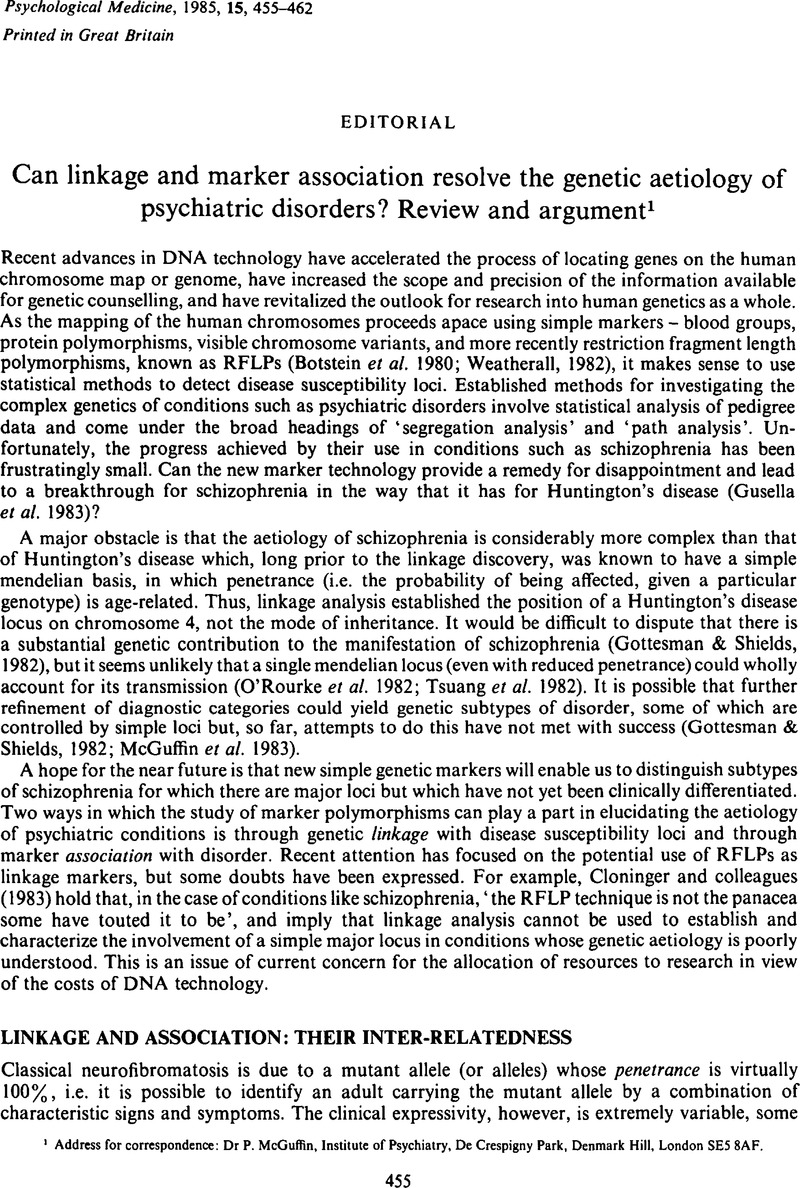Crossref Citations
This article has been cited by the following publications. This list is generated based on data provided by Crossref.
Andrew, B.
Watt, D. C.
Gillespie, C.
and
Chapel, H.
1987.
A study of genetic linkage in schizophrenia.
Psychological Medicine,
Vol. 17,
Issue. 2,
p.
363.
Mc Guffin, Peter
1987.
THE NEW GENETICS AND CHILDHOOD PSYCHIATRIC DISORDER.
Journal of Child Psychology and Psychiatry,
Vol. 28,
Issue. 2,
p.
215.
Goldin, Lynn R.
Delisi, Lynn E.
and
Gershon, Elliot S.
1987.
Relationship of HLA to schizophrenia in 10 nuclear families.
Psychiatry Research,
Vol. 20,
Issue. 1,
p.
69.
Gershon, Elliot S.
Merril, Carl R.
Goldin, Lynn R.
DeLisi, Lynn E.
Berrettini, Wade H.
and
Nurnberger, John I.
1987.
The role of molecular genetics in psychiatry.
Biological Psychiatry,
Vol. 22,
Issue. 11,
p.
1388.
Egeland, Janice A.
Gerhard, Daniela S.
Pauls, David L.
Sussex, James N.
Kidd, Kenneth K.
Alien, Cleona R.
Hostetter, Abram M.
and
Housman, David E.
1987.
Bipolar affective disorders linked to DNA markers on chromosome 11.
Nature,
Vol. 325,
Issue. 6107,
p.
783.
Kidd, Kenneth K.
1987.
Research design considerations for linkage studies of affective disorders using recombinant DNA markers.
Journal of Psychiatric Research,
Vol. 21,
Issue. 4,
p.
551.
Judd, Fiona K.
Burrows, Graham D.
and
Hay, David A.
1987.
Panic Disorder: Evidence for Genetic Vulnerability.
Australian & New Zealand Journal of Psychiatry,
Vol. 21,
Issue. 2,
p.
197.
McGuffin, P.
Farmer, A.
and
Gottesman, I. I.
1987.
Is There Really A Split in Schizophrenia?.
British Journal of Psychiatry,
Vol. 150,
Issue. 5,
p.
581.
Humphreys, Lloyd G.
1988.
Sex differences in variability may be more important than sex differences in means.
Behavioral and Brain Sciences,
Vol. 11,
Issue. 2,
p.
195.
Campion, D.
1988.
Schizophrénie: l’hypothèse dopaminergique à l’épreuve de la génétique moléculaire. I..
Psychiatry and Psychobiology,
Vol. 3,
Issue. 2,
p.
73.
Mayer, Richard E.
1988.
What we really need is a theory of mathematical ability.
Behavioral and Brain Sciences,
Vol. 11,
Issue. 2,
p.
202.
Zohar, Ada
and
Guttman, Ruth
1988.
The forgotten realm of genetic differences.
Behavioral and Brain Sciences,
Vol. 11,
Issue. 2,
p.
217.
Kenrick, Douglas T.
1988.
Biology: Si! Hard-wired ability: Maybe no.
Behavioral and Brain Sciences,
Vol. 11,
Issue. 2,
p.
199.
Benbow, Camilla Persson
1988.
Sex-related differences in precocious mathematical reasoning ability: Not illusory, not easily explained.
Behavioral and Brain Sciences,
Vol. 11,
Issue. 2,
p.
217.
Money, John
1988.
Mathematics as male pathology.
Behavioral and Brain Sciences,
Vol. 11,
Issue. 2,
p.
205.
Backer, Betsy Jane
and
Hedges, Larry V.
1988.
The effects of selection and variability in studies of gender differences.
Behavioral and Brain Sciences,
Vol. 11,
Issue. 2,
p.
183.
Burnett, Sarah A.
1988.
Spatial visualization and mathematical reasoning abilities.
Behavioral and Brain Sciences,
Vol. 11,
Issue. 2,
p.
187.
Jackson, Nancy Ewald
1988.
To understand sex differences we must understand reasoning processes (and vice versa).
Behavioral and Brain Sciences,
Vol. 11,
Issue. 2,
p.
197.
Nyborg, Helmuth
1988.
Mathematics, sex hormones, and brain function.
Behavioral and Brain Sciences,
Vol. 11,
Issue. 2,
p.
206.
Mills, Carol J.
1988.
Rival hypotheses about sex differences in mathematics: Problems and possibilities.
Behavioral and Brain Sciences,
Vol. 11,
Issue. 2,
p.
204.



